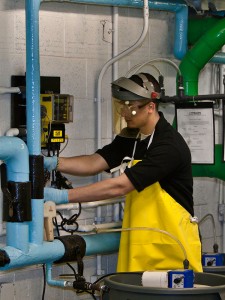
When it comes to the internal environment of your commercial building, one factor you may have overlooked is the air pressure.
When it comes to the internal environment of your commercial building, one factor you may have overlooked is the air pressure. Think about how important air pressure is on an airplane – without that pressurized cabin it would be hard to breathe normally at those altitudes. But here on the ground, having the proper amount of air pressure can help your employees and visitors feel comfortable as well. Here are the ways you can tell when you commercial building encounters air pressure problems.
Types of Air Pressure
You should know that there are two types of air pressure. They are known as positive and negative. Whether you have positive or negative depends on the condition of your commercial building’s HVAC system.
Positive Pressure: Although this might sound like a good thing, it isn’t. When you have positive pressure, it means there’s too much air, and it is being released in unexpected and startling ways. In other words, doors will fly open or slam shut. Sometimes, it may mean that affected doors become virtually impossible to open or close. An inspection of your systems can reveal any problems that may be the cause of this situation. However, you should also remember that the air you’re spending so much money to have heated is slowly escaping while you are too preoccupied to notice
Negative Pressure: When you have negative pressure, it means that the air pressure inside your commercial building isn’t as high as the pressure outside. Thus, the air around your building is being pulled in. This exchange means that doors that typically close inwards will be blowing outwards, which could injure someone who is trying to enter through them. Likewise, these doors will refuse to open.
How the Imbalance Occurs
Hot air: It’s a scientific fact that hot air rises while cold air sinks. Warmer air will eventually circulate to the upper levels of your commercial building. However, this leaves the lower levels vulnerable to the effects of negative air pressure. Furnaces, whether or not they are electrical, act as heat sources that can also accelerate the release of hot air.
Broken fans: Check on the condition of your exhaust fans. You never know when backdrafts or carbon monoxide buildups can occur, both of which are hazardous situations for everyone in your commercial building, not to mention the structure itself.
Fan motors: Fan motors, or blower motors, might operate at full blast. In some cases, that would mean they need to be turned down. But if they aren’t spinning fast enough, that causes positive air pressure problems as well.
Leaking ductwork: Don’t neglect to inspect your ductwork for leaks. Not only can leaks lead to potential water damage, but it can also contribute to unbalanced levels of air pressure or room temperature in different parts of your building.
Crockett Facilities Can Help!
Crockett Facilities Services, Inc. (CFSI) is committed to helping building owners, property managers, engineers, and facility professionals lower their operating expenses through HVAC preventive maintenance. We can develop a cost-effective, customized preventive maintenance plan for your commercial building that will provide you with peace of mind, improved comfort, and energy savings.
To learn more about the importance of HVAC Preventive Maintenance, please contact us at 202.600.2787 or sales@crockett-facilities.com. Our PM contract customers receive priority service with 24/7 emergency service in Maryland, Virginia and Washington, DC.
